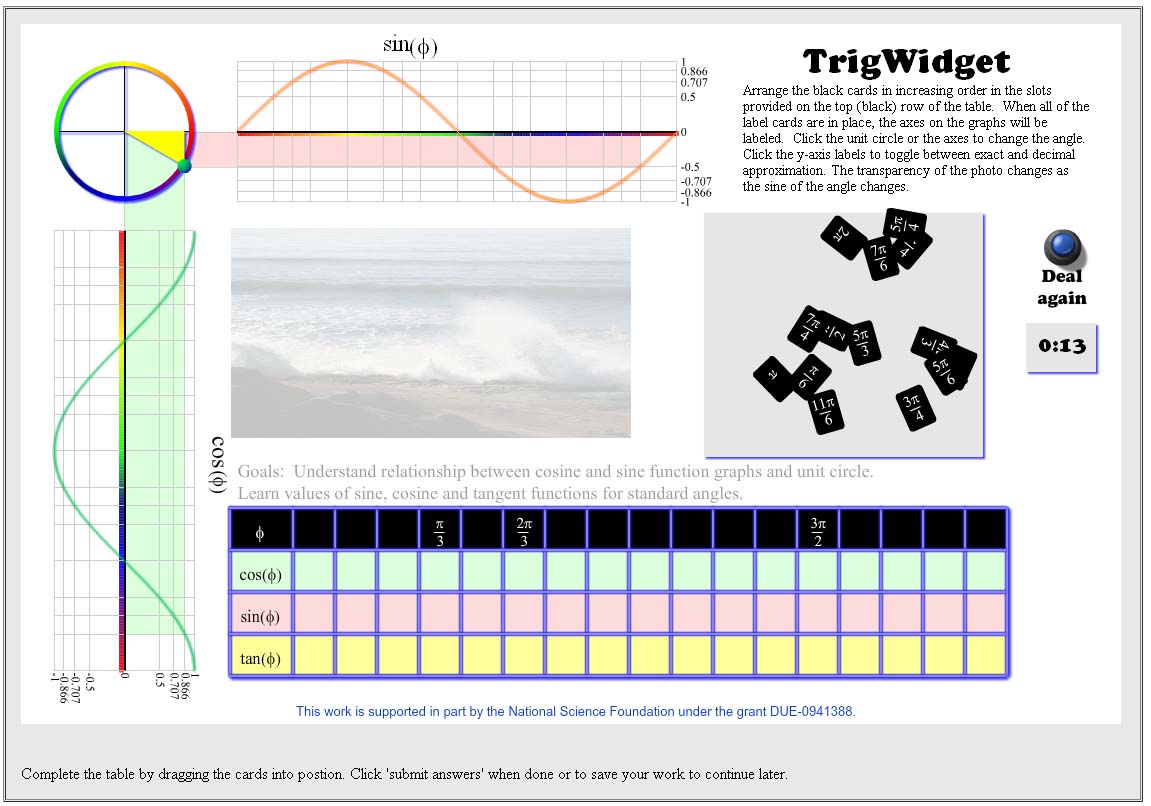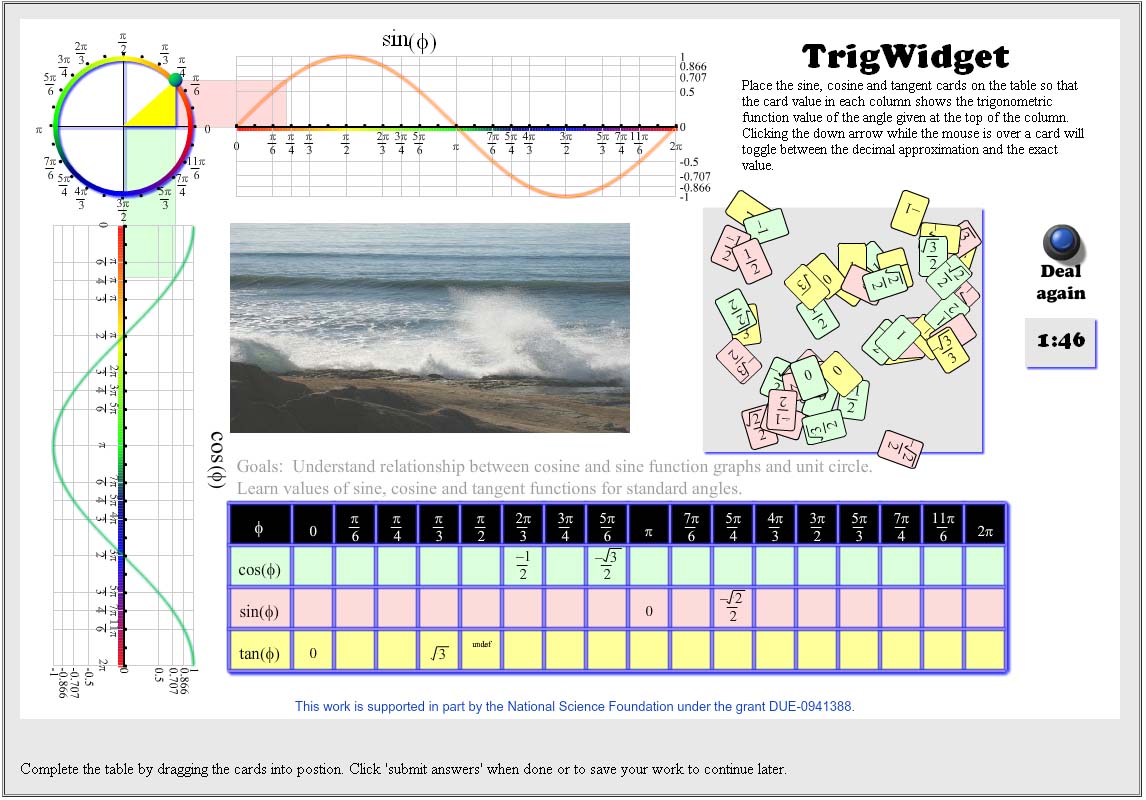Trigwidget Applet Sample Problem
Flash Applets embedded in WeBWorK questions trigwidget Example
Sample Problem with trigwidget.swf embedded
This sample problem shows how to use the trigwidget applet.
A standard WeBWorK PG file with an embedded applet has six sections:
- A tagging and description section, that describes the problem for future users and authors,
- An initialization section, that loads required macros for the problem,
- A problem set-up section that sets variables specific to the problem,
- An Applet link section that inserts the applet and configures it, (this section is not present in WeBWorK problems without an embedded applet)
- A text section, that gives the text that is shown to the student, and
- An answer and solution section, that specifies how the answer(s) to the problem is(are) marked for correctness, and gives a solution that may be shown to the student after the problem set is complete.
The sample file attached to this page shows this; below the file is shown to the left, with a second column on its right that explains the different parts of the problem that are indicated above. Two screenshots of the applet embedded in this WeBWorK problem are shown below:

The screenshot above shows the applet with just a few of the label cards in place. The student must drag the labels of the basic angles into position in order for the axis labels and the labels on the unit circle to appear. The student can turn one of the label cards over by clicking the down arrow after clicking the card. The reverse side of the card provides a decimal approximation in place of the exact value on its flip side.

The screen shot above shows the applet more nearly complete. All of the labels are in place, but very few of the cosine, sine and tangent cards have been placed. The WeBWorK problem only gives credit when the entire table is completed, but it will save the student's progress if the 'Submit answer' button is pressed. It is not possible to place a card incorrectly, however, cards must be close to the correct location to snap into place.
There are other example problems using applets:
GraphLimit Flash Applet Sample Problem
GraphLimit Flash Applet Sample Problem 2
Derivative Graph Matching Flash Applet Sample Problem
USub Applet Sample Problem
| PG problem file | Explanation |
|---|---|
##DESCRIPTION
## Trigonometry review
##ENDDESCRIPTION
##KEYWORDS('trigonometry', 'basic angles')
## DBsubject('Calculus')
## DBchapter('Review')
## DBsection('Trigonometry')
## Date('7/11/2011')
## Author('Barbara Margolius')
## Institution('Cleveland State University')
## TitleText1('')
## EditionText1('2011')
## AuthorText1('')
## Section1('')
## Problem1('')
########################################################################
# This work is supported in part by the National Science Foundation
# under the grant DUE-0941388.
########################################################################
|
This is the tagging and description section of the problem. Note that any line that begins with a "#" character is a comment for other authors who read the problem, and is not interpreted by WeBWorK. The description is provided to give a quick summary of the problem so that someone reading it later knows what it does without having to read through all of the problem code. All of the tagging information exists to allow the problem to be easily indexed. Because this is a sample problem there isn't a textbook per se, and we've used some default tagging values. There is an on-line list of current chapter and section names and a similar list of keywords. The list of keywords should be comma separated and quoted (e.g., KEYWORDS('calculus','derivatives')). |
DOCUMENT(); # This should be the first executable line in the problem. loadMacros( "PGbasicmacros.pl", "extraAnswerEvaluators.pl", "AppletObjects.pl", ); |
This is the initialization section of the problem. The first executed line of the problem must be the
The |
# Set up problem
TEXT(beginproblem());
$showPartialCorrectAnswers = 1;
Context("Numeric");
$ans =Compute("1");
|
This is the problem set-up section of the problem. The trigwidget.swf applet is either completed or not. The applet returns a "1" when the student has completed the work and pressed the "Submit answer" button. Note that any work is lost if the student does not press the "Submit answer" button even if the applet has been completed. |
###################################
# Create link to applet
###################################
$appletName = "trigwidget";
$applet = FlashApplet(
codebase => findAppletCodebase("$appletName.swf"),
appletName => $appletName,
appletId => $appletName,
setStateAlias => 'setXML',
getStateAlias => 'getXML',
setConfigAlias => 'setConfig',
getConfigAlias => 'getConfig',
#initializeActionAlias => 'setXML',
maxInitializationAttempts => 5, # number of attempts to initialize applet
#submitActionAlias => 'getXML',
answerBoxAlias => 'answerBox',
height => '700',
width => '1100',
bgcolor => '#ffffff',
debugMode => 0,
submitActionScript =>
qq{getQE("answerBox").value=getApplet("$appletName").getAnswer() },
);
###################################
# Configure applet
###################################
#no initialization data
$applet->configuration(qq{<XML><stat success="0"/></XML>});
#no initialization data
$applet->initialState(qq{<XML><stat success="0"/></XML>});
TEXT( MODES(TeX=>'object code', HTML=>$applet->insertAll(
debug=>0,
includeAnswerBox=>1,
# reinitialize_button=>$permissionLevel>=10,
)));
|
This is the Applet link section of the problem.
Those portions of the code that begin the line with You must include the section that follows The lines The code
The hidden form fields are created in the code block:
The applet is configured in the code line:
When the submit button is pressed, the hidden form fields defined in this block are filled with information from the applet. The data from the hidden form fields is used in these simple perl subroutines to define the correct answers to the four questions that are part of this WeBWorK problem. The WeBWorK variable $answerString1 is the content of the hidden form field "func". $correctAnswer1 is the solution to the first question. The solutions for the next two questions are defined in a similar way. The final question also has 'DNE' as a possible correct answer for the student to enter. The way that the applet is designed, the left and right limits always exist. |
BEGIN_TEXT
$BR
The graph shown is for the function \(f(x)\).
$BR Compute the following quantities:
$BR
a)
\(f($x1)=\)
\{ans_rule(35) \}
$BR
b)
\(\lim_{x\to {$x2}^+}f(x)=\)
\{ans_rule(35) \}
$BR
c)
\(\lim_{x\to {$x3}^-}f(x)=\)
\{ans_rule(35) \}
$BR
d)
\(\lim_{x\to {$x4}}f(x)=\)
\{ans_rule(35) \}
$BR
END_TEXT
Context()->normalStrings;
|
This is the text section of the problem. The
Mathematical equations are delimited by
There are a number of variables that set formatting: |
############################################################## # # Answers # ## answer evaluators ANS( $correctAnswer1->cmp() ); #checks AnSwEr00001 ANS( $correctAnswer2->cmp() ); #checks AnSwEr00002 ANS( $correctAnswer3->cmp() ); #checks AnSwEr00003 ANS(num_cmp($correctAnswer4,strings=>['DNE'])); #checks AnSwEr00004 ENDDOCUMENT(); |
This is the answer section of the problem. The problem answer is set by the The solution is embedded in the applet and becomes available when the due date has passed.
The |